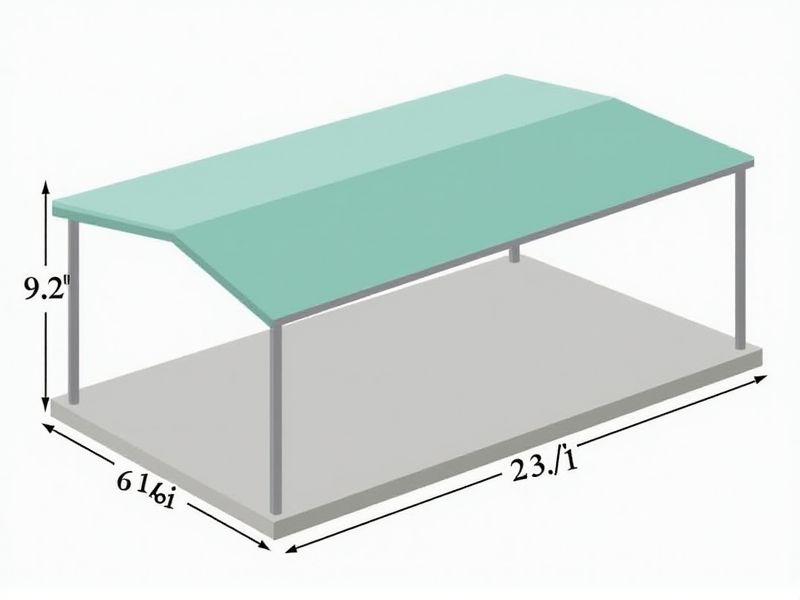
When planning a carport, standard dimensions are important to ensure your vehicle fits comfortably and is protected from the elements. A typical single carport measures about 12 feet wide by 20 feet long, providing ample space for most standard cars or small SUVs. For a double carport, the common size is 20 to 24 feet wide by 20 feet long, accommodating two vehicles side by side. It's helpful to measure your own vehicles and consider any additional storage needs before finalizing the carport dimensions to ensure a perfect fit.
Width
The standard width for a two-car carport typically measures 20 to 24 feet, providing ample space for vehicle maneuverability and access. For single-car carports, a width of at least 12 to 14 feet is recommended to accommodate most vehicles comfortably. If you plan to store vehicles with wider dimensions, such as trucks or SUVs, consider increasing the width by an additional 2 to 4 feet for enhanced convenience. Ensuring proper width not only improves functionality but also adds value to your property by offering flexible use options.
Height
The standard height for carports generally measures between 7 to 8 feet, accommodating most vehicles comfortably. This height ensures that standard vans, trucks, and SUVs can fit without risking damage. When planning your carport, consider local regulations, as some areas may have specific height requirements that can range from 6 to 10 feet. Ensuring proper height not only provides necessary clearance but also contributes to overall structural integrity and usability.
Length
The standard length of a carport typically ranges from 18 to 24 feet, accommodating most passenger vehicles and SUVs. A 20-foot length is often considered optimal, providing ample space for parking and maneuvering. If you own a larger vehicle, such as a truck or a van, a length extending to 24 feet can ensure a comfortable fit. Your specific needs may dictate the ideal dimensions, so it's essential to measure your vehicle before finalizing your carport design.
Clearance
The standard clearance for a carport typically ranges from 7 to 9 feet, ensuring adequate height for most vehicles, including vans and SUVs. A minimum width of 12 to 16 feet is recommended for comfortable maneuvering. For optimal durability, ensure the carport's structure can withstand wind loads of up to 90 mph, depending on your geographical area. Knowing these specifications not only enhances safety but also maximizes functionality for your parking needs.
Roof Pitch
The roof pitch of a carport significantly influences its structural integrity and water drainage efficiency; a minimum slope of 2:12 is typically recommended to ensure proper runoff. A more pronounced pitch, such as 4:12 or 6:12, can enhance both aesthetics and snow load capacity, making it ideal for regions with heavy snowfall. Selecting the right materials, like metal or shingles, tailored to the roof's angle can further optimize durability and maintenance. You should also consider local building codes, as they may dictate specific requirements related to roof pitch and drainage for carport construction.
Post Spacing
Post spacing in carport construction typically adheres to a standard of 8 to 10 feet apart, optimizing both structural integrity and material usage. This spacing allows for adequate support while ensuring the carport remains stable under various weather conditions. By following these optimal distances, you can enhance the longevity and durability of the structure, maximizing protection for your vehicle. When designing your carport, consider using pressure-treated wood or galvanized steel for posts, which can further improve resistance to decay and corrosion.
Gutter Height
The ideal gutter height for a carport generally ranges between 8 to 12 inches, ensuring effective water drainage and preventing overflow. A well-placed gutter system helps channel rainwater away from your vehicle, reducing the risk of corrosion and structural damage. Selecting the appropriate gutter height not only enhances functionality but also complements the overall aesthetics of your carport design. When planning your carport, consider local weather patterns, as areas with heavy rainfall may require higher gutters for optimal performance.
Overhang
A carport with a well-designed overhang enhances protection from the elements, typically extending 2 to 3 feet beyond the structure. This additional coverage helps shield your vehicle from rain, snow, and UV rays, significantly increasing the lifespan of your car's exterior. The overhang can vary in materials, commonly incorporating steel or wood, with a preference for durable finishes that withstand harsh weather conditions. Ensuring proper drainage systems in this design can also prevent water pooling, thus maintaining a clean and functional space beneath your carport.
Ground Clearance
Ground clearance is a crucial standard for carports, typically ranging from 6 to 12 inches, depending on the vehicle type and design preferences. Higher ground clearance allows for easier access and minimizes the risk of scraping the undercarriage of low-profile cars. Ensuring adequate space beneath the structure also prevents water accumulation and facilitates ventilation, reducing potential damage from moisture. When considering your carport installation, assess the average ground clearance of your vehicles to choose an optimal height for protection and functionality.
Load-Bearing Capacity
A carport's load-bearing capacity is crucial for supporting the weight of snow, hail, or rain and can range from 1,500 to 3,000 pounds. It must adhere to local building codes, which often specify a minimum live load of 20 pounds per square foot for residential structures. When selecting a carport, consider durable materials like steel or aluminum, which provide enhanced strength compared to wood, ensuring your carport withstands harsh weather conditions. Evaluate the dimensions, as a standard carport typically measures 12 to 24 feet in width, accommodating various vehicle sizes while maintaining structural integrity.
